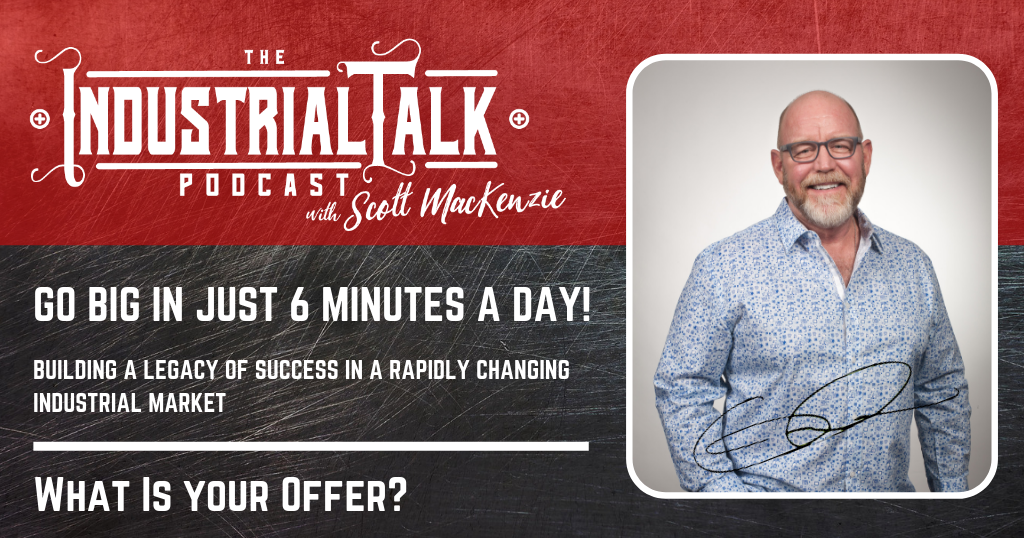Industrial Sales – What Is Your Offer?

What is your offer? I have two questions; 1) Does your services or product solve a Customer Problem? 2) How do you know that your service or product solve a Customer Problem? Answering the 2nd question and working with your Customer ensures a solid answer to the first question. GO-BIG and understand how your offer solves your Customer's Problem.
Podcast Transcript:
[00:01] The industrial talk podcast GO-BIG in just six minutes a day. Building a legacy of success in a rapidly changing industrial market. I welcome to the industrial talk podcast. My name is Scott MacKenzie. I am so glad that you're here. Let's get right to it. We have no time to waste. I hope you have a good day out there.
[00:21] All right. Okay. Uh, we're going to be talking a little bit about what is your offer, what is your offer and how we can get that message out there. But we're going to talk a little bit about what is your offer. The last, uh, go big segment. We talked about customer segmentation and the importance of that. Now I want you to execute upon that because it is all about finding that customer, those customers that need your solution to solve their problem. That makes sense. It's spot on. And once you find them, then you're able to create the content that is necessary for them. That means something to them that communicates solutions to their problems. So we're gonna, we're gonna dive into that. Not right now, but we will. But I just want to make sure you're already executed upon finding that customer segmentation. This episode we're going to be talking a little bit about what is your offer. So I have a couple of questions. One,
[01:28] does your solution service, whatever that is, solve a problem, a customer problem, does your solution or service solve a customer's problem too? How do you know that it does solve a customer problem? So how do you know does it, and then how do you know? I mean, there's a bunch of solutions out there and, and, and I mean it, uh, if you just look around, there's tons of solution. Do they solve the customer's problem? And, and at that's at the crux and that is all a part of the content that you communicate. So if you think that your solution or service solves a customer problems, you can't just go to the customers like, boom, I'm going to throw up and here it is bad. Just this is why it's so important to you. Because you know, if you've been listening, it's know, like, and trust. So you've got to have that interaction with the customer. Hey, customer,
[02:38] okay, what solutions are you looking for? What, what are your problems? Tell me why these problems are or important to you. How are these problems preventing you to get to your goals and strategic objectives? These are important conversations to have. And if you think that your offer satisfies your customers’ needs and problems and solves those problems and you don't ask them, you're missing the boat, you're missing an opportunity to have a meaningful, you know, back and forth conversation about how your solution meets and surpasses what they need to get done and how it solves their problem. So what I challenge you and I challenge you today and it's very simple, whatever that service is, you might have a suite of services, you might have a suite of solutions. And I'm not asking you to look at this elephant of solutions and trying to find a customer that says, okay, hey, hey, see these suites, these, these, this big elephant.
[03:54] Let's look at it and see how it satisfies your problems. No, I'm talking about something a little more digestible. Once again, getting down to those a small burger bite, uh, analogy, take small and then you can begin to uh, consume graters amount. So we're about sliders here. I want you to take that one product, that one service that you offer to the market and then talk to four, five, six of your customers. And important reason why you need to do that is you're getting that market information. You're getting there, you know they have issues over here, but if you're not having that dialogue with those customers, then you're, you're missing out on some great information. So the challenge for you today is to find five, six have of customers have a meaningful conversation of saying, Hey, what is truly your issue? What are your problems? And listen and learn and hear what they have to say
[05:14] because I guarantee you they're going to make you a better company. They're going to make you a better person. They're going to, they know what they're dealing with. And then be able to take that information and align your services and solutions to their needs and problems. Because if they have a problem, they have a name. And they're looking for solutions. You know, as well as I do that there are a number of other companies out there that fall into that same category. Show. Get in front of your customers, just identify one of your services or solutions and have a meaningful conversation. That's it. Very easy, very consumable, very slider like, and enjoy that conversation. Get some information on your customers, said that you, because it's once again about your customer's success. So thank you very much for joining the industrial talk podcast. We will be back tomorrow to talk about more ways to make you a success. Thank you very much.
The post Industrial Sales – What Is Your Offer? appeared first on The Industrial Talk Podcast with Scott MacKenzie.
